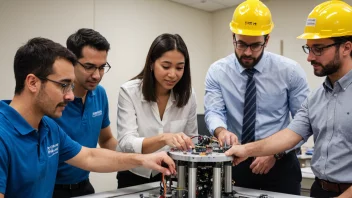In an era defined by rapid technological advancements and complex global challenges, the need for interdisciplinary collaboration in scientific research has never been more critical. As problems become increasingly multifaceted, traditional disciplinary boundaries are often insufficient to address the intricate nature of contemporary issues. This article explores how interdisciplinary collaboration fosters scientific discovery, examines successful case studies, and highlights the benefits and challenges associated with this collaborative approach.
Understanding Interdisciplinary Collaboration
Interdisciplinary collaboration refers to the process where experts from different academic disciplines come together to address a common problem or research question. This approach encourages the integration of diverse perspectives, methodologies, and expertise, ultimately leading to innovative solutions that might not be achievable within a single discipline. The importance of this collaborative effort is underscored by the complexity of problems we face today, ranging from climate change to public health crises.
The Benefits of Interdisciplinary Collaboration
Collaborative research across disciplines offers several key advantages:
- Enhanced Creativity: By bringing together diverse viewpoints, interdisciplinary teams can generate novel ideas and approaches that might not emerge in a more homogenous group.
- Comprehensive Problem Solving: Complex issues often require knowledge from multiple fields. For instance, addressing the COVID-19 pandemic necessitated insights from virology, public health, economics, and sociology.
- Resource Sharing: Collaborative projects can pool resources, including funding, equipment, and expertise, making it possible to undertake larger and more ambitious research initiatives.
- Increased Impact: Research findings that are informed by multiple disciplines are often more relevant and applicable to real-world situations, thus enhancing the potential for societal impact.
Successful Case Studies
Numerous examples illustrate the power of interdisciplinary collaboration in scientific discovery:
1. The Human Genome Project
This landmark project involved geneticists, biologists, computer scientists, and ethicists working together to map the entire human genome. The collaboration not only accelerated the pace of discovery but also raised important ethical questions about genetic research, showcasing the need for diverse expertise.
2. Climate Change Research
Addressing climate change requires input from climatologists, environmental scientists, economists, and social scientists. By working together, these experts can develop comprehensive models that account for the environmental, economic, and social dimensions of climate change, leading to more effective policies.
3. The Development of mRNA Vaccines
The rapid development of mRNA vaccines during the COVID-19 pandemic exemplifies interdisciplinary collaboration in action. Biotechnologists, immunologists, and public health experts united to create vaccines that have saved millions of lives. Their combined knowledge of molecular biology, vaccine technology, and epidemiology was crucial in addressing the urgent public health crisis.
Challenges of Interdisciplinary Collaboration
While the benefits are significant, interdisciplinary collaboration also presents several challenges:
- Communication Barriers: Experts from different fields often use distinct terminologies and methodologies, which can lead to misunderstandings.
- Disciplinary Silos: Traditional academic structures and funding mechanisms may prioritize single-discipline research, making it difficult to secure support for interdisciplinary projects.
- Conflict of Interests: Different disciplines may have varying priorities or methodologies, which can lead to conflicts within collaborative teams.
Fostering Interdisciplinary Collaboration
To overcome these challenges and promote effective interdisciplinary collaboration, several strategies can be employed:
- Encourage Open Communication: Establishing clear communication channels and fostering an environment of respect and openness can help bridge disciplinary divides.
- Integrate Education and Training: Academic institutions can promote interdisciplinary education by offering programs that encourage students to engage with multiple disciplines.
- Support Collaborative Research Initiatives: Funding agencies can create grant opportunities specifically designed for interdisciplinary projects, helping to break down traditional silos.
The Future of Interdisciplinary Collaboration in Science
As society continues to face complex challenges, the importance of interdisciplinary collaboration in scientific discovery will only grow. The ability to combine diverse expertise and perspectives is essential for developing innovative solutions that are both effective and sustainable. By embracing collaboration, the scientific community can enhance its capacity to address pressing global issues and improve the quality of life for people around the world.
In conclusion, interdisciplinary collaboration represents a powerful approach to scientific discovery, allowing researchers to tackle complex problems with creativity and comprehensive insight. While challenges exist, the benefits of such collaboration far outweigh the drawbacks. As we move forward, fostering a culture of collaboration will be crucial in advancing knowledge and addressing the myriad challenges facing our world today.






